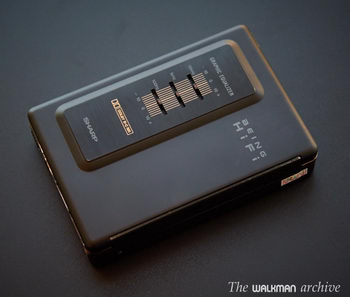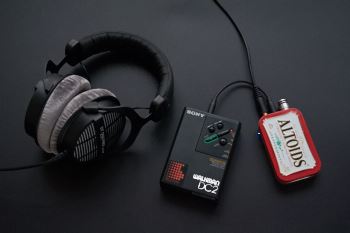|
Panasonic had also some few gems, like the RQ-S60 or the RQ-S80. These two models offer a good quality (especially the latter one), but they are pretty hard to find, even less in perfectly working condition. So expect that the belt should be replaced (look for thin belts from Marian). Probably all caps are faulty and maybe another problems as well. The S80 sounds really well, but it lacks the power of the bass that other DDs have, probably due to a weak headphone amplifier. The difference is not big, however. The other problem is that the bass amplification system is almost useless for home use, but it can be very helpful outside. The reason is that it’s very aggressive: it raises bass and treble a lot, even in its softer mode. Even worse: none of these presets can’t be operated without the original wired remote… which has the headphones soldered, leaving you no option for using your own ones.

The Panasonic RQ-S80 WITH REMOTE it's the best sounding Panasonic ever, with it's 12 laminated head.
The other
problem is that many functions are lost without the remote... that doesn't allow you to use your own headphones.
Kenwood had some very interesting models that compete with AIWA’s best ones. In fact they actually compete at the very same level because… many of them were made by AIWA! Yes, they were re-branded models with the same basis but a different external design and a proprietary Kenwood dynamic bass amplification. Most remarkable were those based on best AIWAs: CP-9RC (based on the PX101), CP-C7 and CP-M7. Probably the best sounding one is the latter, but I still didn't test it, as mine has not been serviced.

Kenwood CP-R9, a licensed AIWA PX101 with some changes: the DSC system replaces the original DSL for bass amplification.
SHARP also had a few good players. Many of those players were only sold inside Japan, so it’s pretty difficult to find one outside the red rising sun’s country. One of my favorites is the JC-C50, which not only features a good head, Dolby B&C and X-BASS, but also a 3-band EQ, which is probably the only top-level player which combines those three features together.

Sharp JC-C50, one of the best sounding models of this brand.
This nice player sounds pretty good, but the treble response lacks some clarity against the best SONY DD. Not something you would notice without a direct comparison, though.
Numbers doesn’t tell the whole story
During many years, I thought that the specs were all you must know about a music player. If numbers score higher, then that one sounds better. that's simple, huh? Well... not. Frequency response, dynamic range, Dolby performance… don’t tell so much about the real performance of the player. Yes, it can sound weird, but it is the truth.
Over the years I believed the opposite. I read through the brochures and analyzed every walkman’s technical specifications. And I made the conclusion very quickly: best ones were those who had more features and scored higher specs, like the AIWA HS-JX707 and the SONY WM-701C. For example: a SONY WM-B39 has a frequency response of 40-15kHz... the same as the WM-DD30. So, they should sound the same, right? Well... try yourself and you'll quickly realize how wrong is that statement.
But… what’s the problem? Well, specs doesn’t tell the whole story. Even worse: manufactures don’t tell you all the specs. One of the best examples is the wow&flutter. There’s almost no information about it. No brand said what’s the W&F of any of their models (except a very few ones), maybe because all of them would score low. And that’s a very important specification. Many of my walkmans have a pretty good w&f, but many mid-range have difficulties to play a piano solo recording, because it’s one of the worst thing you can play with bad W&F. Not to talk about low range models…
But there’s another important point that no brands gave any information about: the quality of the headphone amplifier. Once you start walking the [long] way to the absolute quality, sooner or later you’ll realize that it’s not all about the source (the walkman itself) and the headphones, but also the amplifier. Yes, every walkman has a little amplifier inside, which generates the power to drive those headphones. And it has to be powerful enough to drive good headphones. But there’s a problem: tiny amplifiers are usually weak and don’t reach the needed level well enough. The power source has a lot to do with that: the lower the voltage, the bigger the problems. So, as you can guess, those which are powered by four batteries are probably better than those which use two, and the latter ones are better than those which use only one or a tiny gumstick battery.
In that matter, the SONY WM-D6C plays another league. It is a professional walkman, powered by four ‘AA’, that even has a line out jack, so it’s the best prepared for the task of them all. The SONY WM-DC2 is very well prepared too, as it has also a very powerful line out.
If you look for something outstanding, I definitely recommend a good, well serviced D6C. It has all you need: quality and power. Put it beside an iPod beside and the D6C will eat it for breakfast (same for almost every smartphone like iPhones or Samsungs). The only problem is that it’s pretty big. If you look for something smaller, I can recommend you the following solution: a good, restored, WM-DC2, that sounds almost as well. And if you connect the line-out of the DC2 to a good portable headphone amplifier, what you’ll get is all the quality of the source and all the quality of a top-level amplifier, which will drive without problems even the biggest and most power-hungry full-size headphones.

My super-DC2 with a JDS Labs CMoyBB and Beyerdynamic DT990.
If you look for a better amplifier, there are other options out there, though some are very expensive, like this Emmeline P-51 Mustang:

SONY WM-DC2 with Emmeline Mustang P51. Photo: Toocool.
Anyway, you may bear in mind that getting a good source is just half the thing. The other half is the headphone. And it's actually more important than the source to achieve the goal: put the right waves in your ears. I'd say the headphone is 70% of the result, being the 30% the walkman. As it is so much important, I wrote an article titled 'Which headphone should I use with my walkman?' that I think you must read. This article is also worth to read: Is it all in your headphones?
|
![]()
![]()
![]()
